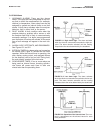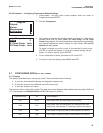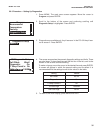
MODEL FCL-1056 SECTION 5.0
PROGRAMMING THE ANALYZER
5.5.4 Procedure – Configuring the Measurement
1. Press MENU. The main menu screen appears. Move the cursor to
Program and press ENTER.
2. Choose Measurement.
3. The screen at left appears only if you have an FCL-02. Choose Sensor 1
(chlorine) or Sensor 2 (pH).
4. The screen summarizes the present configuration for sensor 1 (chlorine).
If you have an FCL-02 the items are Measure, Units, Filter, Free Cl
Correct, and Resolution. If you have an FCL-01, the items are Measure,
Units, Filter, Manual pH, and Resolution. Only four items are shown at
a time. To view the remaining items, scroll to the bottom of the screen and
continue scrolling.
To make a change, move the cursor to the desired line and press ENTER.
A screen will appear in which the present setting can be edited. To store
the setting press ENTER.
a. For Measurement choose Free Chlorine. Do not choose pH
Independ. Free Cl.
b. Leave Filter at the default value (5 sec) unless readings are noisy.
c. If you have an FCL-02, choose either Live/Continuous or Manual
for Free Cl Correct (free chlorine correction). Live/Continuous
means the analyzer will use the pH measured on the second channel
to continuously correct the chlorine reading for changes in the sample
pH. Manual means the analyzer will use a fixed pH value entered by
the user to convert the raw chlorine signal to a ppm reading.
d. If you have an FCL-01, Free Cl Correct (free chlorine correction) will
not appear. Instead, enter the desired pH correction value for Manual pH.
Program
Outputs
Alarms
Measurement
Temperature
Measurement
Configure?
Sensor1
Sensor 2
Sensor 1
S1 Configure
Measure Free Chlorine
Units: ppm
Filter: 5 sec
Free Cl Correct Live/C
Measure:
31
5. RESOLUTION. The pH display resolution is user selectable: XX.X or XX.XX.
6. FILTER. The analyzer applies a software filter to the raw voltage value coming from the pH sensor. The filter
reduces noise, but increases the response time. See section 5.5.2 for more information.
7. REFERENCE IMPEDANCE. Usually the impedance of the reference electrode in a pH sensor is low. However,
a few pH sensors have high reference impedance, and the analyzer must be told that the reference
impedance is high. The pH sensor used in the FCL-02 has low reference impedance.


















